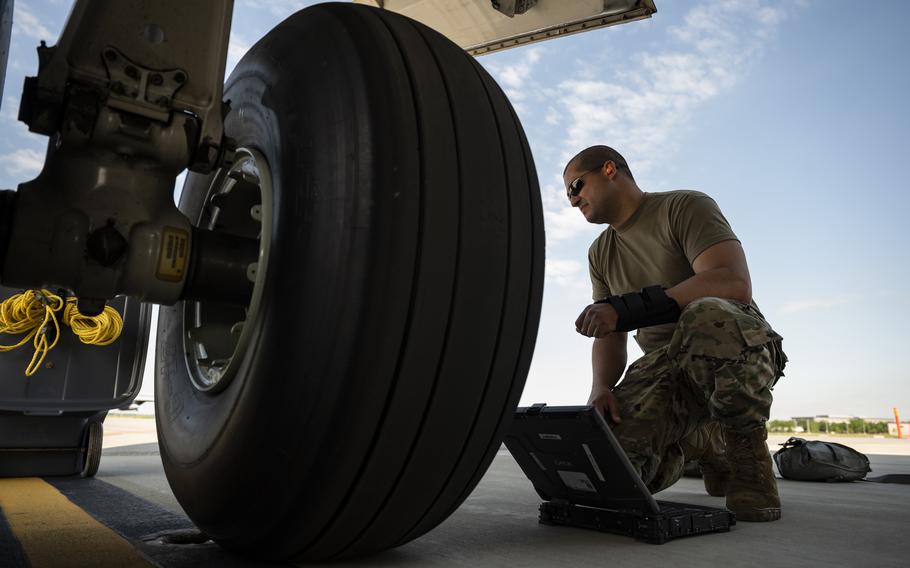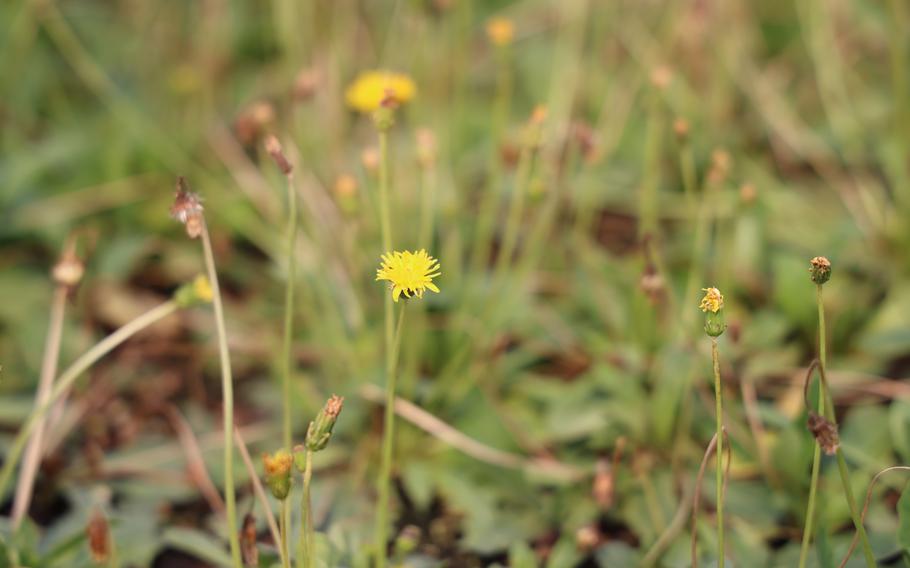
Tech. Sgt. Jorge Padron, 911th Aircraft Maintenance Squadron crew chief, conducts a tire inspection at the Pittsburgh International Airport Air Reserve Station, Pa., June 6, 2021. The Air Force is spending millions of dollars on a program to make rubber from a certain species of dandelion that grows in the United States and use it to produce items such as aircraft tires to cut dependency on foreign supplies, service officials said. (Joshua Seybert/U.S. Air Force)
WASHINGTON — The Air Force is spending millions of dollars on a program to make rubber from a certain species of dandelion that grows in the United States and use it to produce items such as aircraft tires to cut dependency on foreign supplies, service officials said.
The program is being spearheaded by the Air Force Research Laboratory and involves three private companies — BioMADE, American tire giant Goodyear and small Ohio-based business Farmed Materials. If successful, the program could open a new domestic supply of natural rubber.
BioMADE, a manufacturing innovation institute sponsored by the Defense Department that specializes in biomanufacturing, has contracted Farmed Materials to cultivate the dandelions and Goodyear will produce the aircraft tires and make certain that they meet Air Force specifications.
“We are embarking on a new course with Goodyear to bring the latest technologies to agriculture, plant breeding and extraction processes that no one has ever done before,” said Chuck Joffe, chief commercial officer for Farmed Materials. “It will increase efficiency and rubber quality dramatically.”
For decades, the world’s natural rubber has typically come from Hevea brasiliensis trees in Asia and Africa, but the Air Force program plans to start getting it from the kok-saghyz dandelion, which grows in abundance in the United States.
The milky-like substance that produces natural rubber can be found in the leaves, stems and roots of rubber trees and kok-saghyz dandelions. In the dandelions, more commonly known as TK dandelions, the substance is harvested by crushing its roots.
“This particular species of dandelion is different than what’s in your yard,” said Angela Campo, program manager at BioMADE. “The quality of [its] rubber is similar to what you get from the rubber tree. So that’s what made it particularly desirable for this project.”

The Kok-saghyz dandelion species, captured July 28, 2022, at the Amherst Greenhouse in Harrod, Ohio, accumulates rubber in its roots, which can be extracted for further use. The Air Force Research Laboratory entered a multimillion-dollar, multiyear program in spring 2022 with BioMADE, Farmed Materials and The Goodyear Tire & Rubber Company to develop a domestic source of natural rubber from this species of dandelion for use in the production of U.S. Department of the Air Force aircraft tires. (Jonathan Taulbee/U.S. Air Force)
There are substantial differences between natural rubber and synthetic rubber. The natural variety tends to be stronger, more flexible and more heat-resistant – making it suitable for items such as aircraft tires. More so, having vast domestic supplies of TK dandelions in the United States offers the Air Force an unique opportunity to skirt foreign supply chains and lower costs, officials said.
Once the dandelions begin producing rubber and it’s tested and qualified, the Air Force will no longer need to rely on foreign supply lines that are vulnerable to disruption, as happened during the coronavirus pandemic. The service said it buys — on average — nearly 100,000 tires per year for aircraft and land vehicles at a cost of $100 million. Those tires are produced with foreign-supplied rubber.
Another major advantage with TK dandelions is they make their rubber-producing substance much quicker than rubber trees make theirs. It takes rubber trees seven years to produce enough for production, while TK dandelions can be harvested every six months.
The Air Force said the number of dandelions needed to produce one aircraft tire depends on the size of the tire and its purpose. But the service noted it expects a single acre of cultivated TK dandelions will eventually allow Goodyear to produce 200 to 400 passenger car tires.
Barry Burton, an engineer in the Air Force Research Lab’s Manufacturing and Industrial Technologies Division, said he’s optimistic the U.S.-produced rubber will show within five years that it’s good enough for military aircraft tires, which could then begin production in a few years from that point.
However, Burton emphasized merely producing the dandelion rubber won’t be enough. He said there will also need to be enough support from the farming and agricultural sectors and there must be enough demand for the TK rubber once it’s made.
The Air Force program isn’t the first time the U.S. military has looked into producing rubber from the TK dandelion. The Pentagon looked in that direction 80 years ago during World War II when the normal rubber supplies from Asia were disrupted by fighting in the Pacific. The military ultimately abandoned the TK dandelions when the war ended and the Asian supply lines reopened.
Concerns that the same kind of trouble could re-emerge have only increased in recent years, particularly after the coronavirus crisis and Russia’s ongoing war in Ukraine have proved to be disruptive to international supply chains. For that reason, the Air Force sees the rubber supply as a national security and a readiness issue.
“What would happen to our warfighting capability and national security capability if we couldn’t produce aircraft tires?” Burton asked.
“We have to find another way to secure the supply chain,” Campo said, noting the world’s demand for natural rubber is increasing. “In China, there are more people who own cars now than they did 10 years ago. Eventually, what is produced in the world is not going to meet the demand, and we’re getting closer and closer to that point. So, we have to, as a country, start planning ahead.”
The service didn’t say exactly how much money is being dedicated to the program to open a domestic source of natural rubber, offering only that it’s a “multimillion-dollar program.”
Burton and Campo said if all goes well, it will take a few years for the TK-made rubber to ramp up to production scale. The first couple years would be spent planting and harvesting the dandelions, studying the chemical composition of their rubber and then testing it. Prototypes would also need to be built and tires made from TK rubber would eventually be qualified for military aircraft.
“It’s a slow process,” Campo said. “We have to go aircraft by aircraft. This is not a, ‘We test one tire and it’s good for everybody.’”
Moreover, some experts said having a domestic supply of natural rubber won’t only benefit the military. The Air Force said Goodyear, for example, already recognizes the value of sourcing TK rubber for all its tires, military and commercial, sometime in the future.
“This benefit of bolstering U.S.-based agriculture, bolstering U.S.-based manufacturing capability, bolstering U.S. supply chains … and controlling our own destiny is absolutely important,” Burton said.